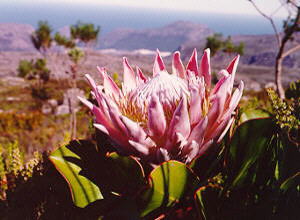
Home
Mission
Overview of Project
Project Staff
Sponsors
Achievements
Checking, Illustrations
Upcoming Activities
Id and Species Lists
Protea Information
Protea Gallery
Growing Proteas
Interim Dist. Maps
Publications
Afrikaanse Inligting
![]()
Introduction to the Protea Atlas Project
Introduction
Southern Africa is rich in plant species with some 24 000 known taxa. About 80 per cent of these plants are endemic - they occur nowhere else in the world. Of these some 3 435 species - some 14 per cent - are listed in the Red Data Book for plants and are in imminent danger of extinction. This is the highest concentration of threatened plant taxa in the world!
The distribution of plants within southern Africa is uneven. The Cape Floral Kingdom covers less than 6% of the region, but contains 9 000 species - over one third of the subcontinent's plant biodiversity. 80% of the plant species in the Cape Floral Kingdom are endemic, and most are found in a single vegetation type - Fynbos. Some 1 500 of these are in the Red Data Book for plants. Not only is the Cape Floral Kingdom the world's hottest Hot Spot, but it is in danger of losing many of these species.
Hot Spots are defined as areas having a high species richness and a high proportion of endemics. Apart from the Cape Floral Kingdom, there are seven other recognised Hot Spots in southern Africa, including the Eastern Mountains (Drakensberg Escarpment and foothills), Pondoland (on the eastern Coast) and the Wolkberg (North-western Escarpment).
The metropolitan area of Cape Town has been identified as a global crisis area: with 84 species of plants threatened with extinction on the Cape Flats and a further 140 on the Peninsula Mountain Chain, it tops by far the list of cities which are destroying their natural heritage. Something has to be done!
Despite the richness of southern Africa's flora and the enormity of the threats, local people are largely unaware of the floral conservation issues within the subregion. There are also too few taxonomists, botanists, ecologists and conservationists to monitor and research the flora and address the urgent problems. Conservation requires that we document our biodiversity, understand our ecosystems, and timeously identify the threats to our flora and fauna. Only through knowledge can we wisely use, manage and conserve our biodiversity.
the alpha taxonomy of proteas is relatively complete making identification fairly straight forward; protea ecology reflects the role of nutrients, fire and mankind in sustaining biodiversity on the subcontinent; proteas are relatively safe from direct commercial exploitation - unlike succulent plants and bulbs; and, some 120 of the 370 protea species are listed in the Red Data Book for plants as threatened with extinction by mankind.The Protea Atlas Project offers an ideal educational opportunity for ecology and environmental awareness. In teaching amateurs identification techniques, data collection and awareness of ecology and conservation, an understanding of environmental issues will develop and engender an appreciation of the veld, contributing to an enhanced conservation ethic.
Back Overview
